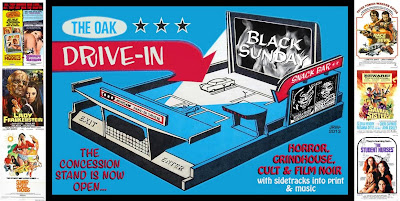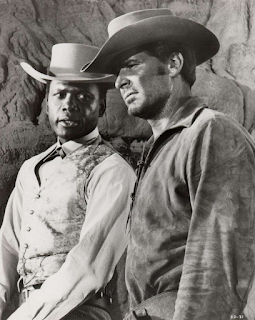The James Garner Blogathon hosted by Realweegiemidget Reviews
DUEL AT DIABLO opens and closes with a bloody knife slicing through the screen to reveal the credits and in-between is a bloody & violent story of bigotry and racism that while adding elements that are coming more to the forefront in the cinema of the '60s (blood, violence & sex), keeps it's foot firmly rooted in the classic Hollywood western. Director & producer Ralph Nelson doesn't so much drag the traditional western into the '60s but makes for what all intents are a classic western but mixes in some more adult themes in the plot while adding darkness & conflict to the lead characters. Like most American westerns made in this time period, it already shows the influence of the Euro-westerns that were beginning to gain an audience. Nelson would really bring the violence to the forefront in his infamous SOLDIER BLUE in 1970
This was the first western that James Garner did following his successful run on the TV series MAVERICK and his character here is a far cry from the easy-going Brett Maverick and along with his next western, the John Sturges HOUR OF THE GUN (1967) where he played a vengeance-driven Wyatt Earp they both probably appealed to him with the darker lead characters.
Opening on a sun-baked desert with opening credits containing a rather odd psychedelic look to them (more than a couple films of this era have an unfortunate font choice) with the title card proudly proclaims "Ralph Nelson's DUEL AT DIABLO". We see cavalry scout Jess Remsberg (Garner) who finds a figure strung upside down over a smoldering fire which is seen in gruesome close-up is a foretelling of the sometimes brutal story to come. He then spies a lone figure being pursued by several Apaches and upon rescuing he finds it to be a white woman. He brings her to the nearest army post and arriving there discovers she's Ellen Grange (Igmar Bergman regular Bibi Andersson) who was captured by the Apache, then escaped and was attempting to get back to them to be with her child whom she had with one of them. None of this sits too well with the townspeople and in particular, her husband Willard (Dennis Weaver TERROR ON THE BEACH) who tells her "any decent woman would've killed herself".
It's interesting that Poitier's race is never brought up or even mentioned during the course of the film. At the film's climactic battle, the soldiers defer to his judgment with McAllister noting "you were a pretty good Sgt. once". Dressed in a fancy suit and chomping on a cigar his character makes a contrast to the bedraggled look of the others. Poitier also appeared in the western BUCK AND THE PREACHER and he seemed to fit nicely into the western genre. Although they only share a couple of scenes together he has a nice rapport with Garner (they team-up for a fight at one point to save Ellen Grange from a violent gang rape) and it kind of makes you wish they had teamed for another film.
Garner at the time was trying to break away from his nice-guy image and his Jess Remsberg is almost the direct opposite of Brett Maverick. Unshaven, raw & dusty and handy with a gun and like in HOUR OF THE GUN he's driven by revenge. The same year also appears in GRAND PRIX as another "driven" (so to speak) character but for fame not revenge, but at the core not that far from Jess Remsberg. Ironically he would return to his Brett Maverick type-persona (although with a gun) in the two highly enjoyable "Support Your.." westerns in the early '70s.
They are two well-staged and violently bloody action sequences that show little of the glory or heroics of battle. The soldiers are driven slowly back into the box canyon while being picked off one by one and left to die. Although they are shown as savage, the Apache is also shown as savage with a reason and a purpose (although as mentioned only Remsberg seems to realize this), and in the end, it's left to the conclusion that the cycle will repeat itself soon.
Although the role of Ellen Grange could have easily taken by any number of American actresses (Angie Dickinson comes to mind) Andersson was probably added to help with the European box office. Although she doesn't get to do much, she brings a quiet dignity to her role and there's a hint at developing romance between her and Garner. Her role can be compared to Candice Bergen's in Nelson's later SOLDIER BLUE. Bill Travers was a Shakespearean stage actor and with his commanding voice, he brings a touch of the Bard to his gruff cavalry commands. Weaver at the time was also best known for his role on TV with his long-running Chester on GUNSMOKE and like Garner seems to relish playing a darker persona.
Filmed in the arid area around Kanab, Utah (a popular Western production location), it was shot by Charles F. Wheeler who had previously hap been the DP a couple of Twilight Zones and would go on to a long career in TV and motion pictures. The jangly theme music by Neal Hefti seems more suited to the comedies he usually scored but the Apaches have an interesting guitar-driven theme.
Oddly the film contains a couple of foreshadowing's to BLAZING SADDLES as a horse is punched at one point and the role of the Apache leader Chata is played by Jewish actor John Hoyt. There are a few familiar faces lurking around including perennial heavy John Crawford (NIGHT MOVES) as a slimy sheriff, Willan Redfield (FANTASTIC VOYAGE) as a Sgt. and director Nelson (billed as Alf Elson) pops up at the end as an officer.
This was the first western that James Garner did following his successful run on the TV series MAVERICK and his character here is a far cry from the easy-going Brett Maverick and along with his next western, the John Sturges HOUR OF THE GUN (1967) where he played a vengeance-driven Wyatt Earp they both probably appealed to him with the darker lead characters.
Opening on a sun-baked desert with opening credits containing a rather odd psychedelic look to them (more than a couple films of this era have an unfortunate font choice) with the title card proudly proclaims "Ralph Nelson's DUEL AT DIABLO". We see cavalry scout Jess Remsberg (Garner) who finds a figure strung upside down over a smoldering fire which is seen in gruesome close-up is a foretelling of the sometimes brutal story to come. He then spies a lone figure being pursued by several Apaches and upon rescuing he finds it to be a white woman. He brings her to the nearest army post and arriving there discovers she's Ellen Grange (Igmar Bergman regular Bibi Andersson) who was captured by the Apache, then escaped and was attempting to get back to them to be with her child whom she had with one of them. None of this sits too well with the townspeople and in particular, her husband Willard (Dennis Weaver TERROR ON THE BEACH) who tells her "any decent woman would've killed herself".
We're then introduced to the cavalry troop commander Lt. Scotty McAllister (Bill Travers GORGO) and ex-cavalry Sgt. named Toller (Sidney Poitier BUCK AND THE PREACHER). This desperate group finds themselves thrown together in a climactic battle of attrition with a band of Apaches who are after a shipment of ammunition being escorted by McAllister. We also learn that that Garner's Remsberg is hunt down and kill the person responsible for the death (and scalping) of his Apache wife. The script was written by Marvin H. Albert (from his novel Apache Rising) brings all these elements and the characters' connections to them along with each other together at the climax.
Ellen Grange is treated horribly by both the town folks and the Apache and their leader Chata (John Hoyt THE BIG COMBO) blames her for the death of his son (who's the father of her baby). She seems to have no allegiance to either world as she simply cares for her child. Like ULZANA'S RAID from later in 1975, DUEL doesn't downplay the cruelty of the Apaches (although ULZANA'S RAID was much more graphic in its depiction). Only Garner's character seems to show any real attempt to understand the Apache and why they escaped from the reservation to begin their raid. In the film's final moments, he ruefully says to himself "why on earth would they ever want to stay there..."Garner at the time was trying to break away from his nice-guy image and his Jess Remsberg is almost the direct opposite of Brett Maverick. Unshaven, raw & dusty and handy with a gun and like in HOUR OF THE GUN he's driven by revenge. The same year also appears in GRAND PRIX as another "driven" (so to speak) character but for fame not revenge, but at the core not that far from Jess Remsberg. Ironically he would return to his Brett Maverick type-persona (although with a gun) in the two highly enjoyable "Support Your.." westerns in the early '70s.
They are two well-staged and violently bloody action sequences that show little of the glory or heroics of battle. The soldiers are driven slowly back into the box canyon while being picked off one by one and left to die. Although they are shown as savage, the Apache is also shown as savage with a reason and a purpose (although as mentioned only Remsberg seems to realize this), and in the end, it's left to the conclusion that the cycle will repeat itself soon.
Filmed in the arid area around Kanab, Utah (a popular Western production location), it was shot by Charles F. Wheeler who had previously hap been the DP a couple of Twilight Zones and would go on to a long career in TV and motion pictures. The jangly theme music by Neal Hefti seems more suited to the comedies he usually scored but the Apaches have an interesting guitar-driven theme.
Oddly the film contains a couple of foreshadowing's to BLAZING SADDLES as a horse is punched at one point and the role of the Apache leader Chata is played by Jewish actor John Hoyt. There are a few familiar faces lurking around including perennial heavy John Crawford (NIGHT MOVES) as a slimy sheriff, Willan Redfield (FANTASTIC VOYAGE) as a Sgt. and director Nelson (billed as Alf Elson) pops up at the end as an officer.





































Thanks for joining with this film with such a fab post with some great pics. I do love seeing how film posters translate in different countries and so it was a real treat to see this in your post.
ReplyDeleteThanks Gill. I do love adding those pics to my posts:)
Delete